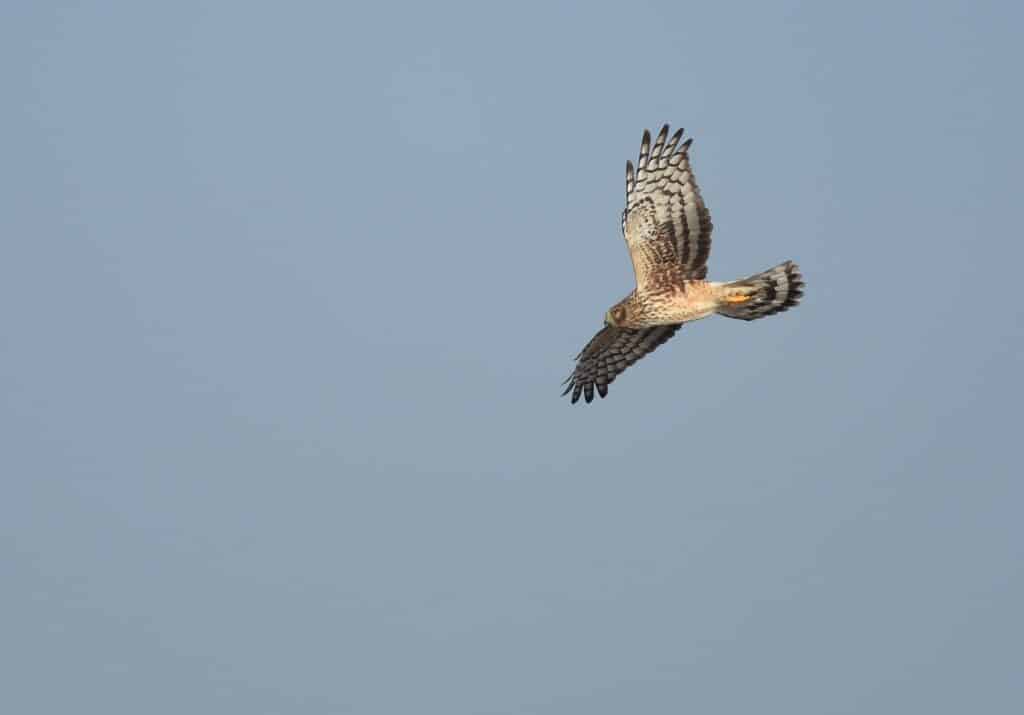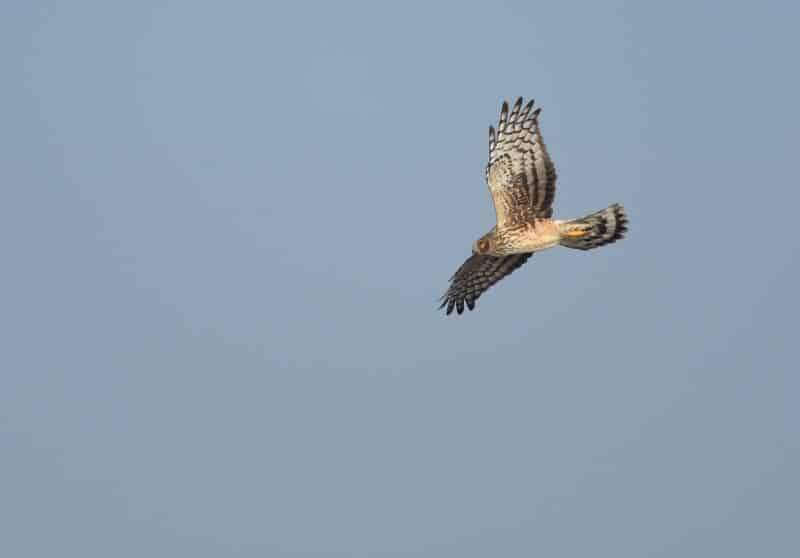by Dr. Sarah Treanor Bois
Director of Research & Education at the Linda Loring Nature Foundation
Years ago my husband and I eloped on a Nantucket Beach. We couldn’t decide exactly which spot to say our “I Do’s.” As we weighed the pros and cons of each location, a Northern Harrier flew low overhead. She landed on a post by one of the beach entrances and projectile pooped into the path. “That looks like the way,” I said to my betrothed. Ten years later the harrier blessing is still strong. In fact, I recently learned that some Native American tribes believe that seeing a harrier hawk on your wedding day is a sign of a long, happy marriage. Thanks Wikipedia.

What’s so special about Northern Harriers? Northern harriers are accipiter hawks in the same family as eagles, vultures, and kites. However, their flat faces make them look more like an owl than any of their closest relatives. Their facial disks allow them to hunt by sound as well as by sight much like an owl—a good feature when hunting in the fog of the Gray Lady.
In flight, Northern Harriers are distinctive: their long slim bodies and slender tails gliding low over a grassland or marsh holding their wings in a Vshape. They seem to barely flap their wings as they hover over the heathlands looking for a snack.
Female harriers are light brown above and buffy below. Their undersides are heavily streaked with dark brown. Females are also about 20% larger than males. Adult males are smaller and gray with black wingtips. This helps give it the nickname “grey ghost,” a perfect moniker for a foggy day in the moors. The juveniles, which are likely out and about now, are mostly dark brown above and cinnamon colored below. Having just fledged, they may also appear a little clumsy on the wing. All three have the distinctive white rump patch easily distinguishable from other birds in our area.
Harriers hunt almost exclusively on the wing for small mammals like meadow voles, white-footed mice, and even other small birds and sometimes snakes. They’ll also take the occasional rabbit. Unlike other hawks, harriers have historically been favored by farmers because they eat agricultural pests that can damage crops without going for chickens.
Throughout much of its range, Northern Harriers are listed as endangered or threatened. Their populations first declined, like many birds of prey, with the widespread use of DDT. With the ban of DDT in 1972, many populations rebounded.
In Massachusetts, Northern Harriers are listed under the Massachusetts Endangered Species Act as a species of special concern. Their declining populations are primarily due to loss of open habitats throughout much of their breeding range. Historically Northern Harriers were known as Marsh Hawks, indicating their other habitat preference, also in decline throughout the eastern US. Nantucket, however, has extensive acreage of sandplain grassland, heathland, and open marsh habitats—perfect for nesting harriers. Another plus for Nantucket is the lack of mammals. Sure, we have rabbits, shrews, rats, and field mice, but aside from our deer herds, there are no large mammals particularly mammal predators (we will save feral cats for another day). Visitors are often surprised to learn that on Nantucket we have no raccoons, foxes, chipmunks, or even skunks (this despite being positive they smelled them in the night). This lack of mammalian predators is a bonus for groundnesting birds like harriers.
Northern Harrier nests, despite being on the ground, are highly secretive. I was once conducting vegetation surveys along the south coast of the island. Unbeknownst to me, there was a Northern Harrier nest right in my transact path. I screamed bloody murder when the adult female flew directly up at me just as I was about to step on the nest. She had been covering the hatchlings with her camouflage body until necessary to move.
Before I could bolt away, I saw three little wrinkly chicks covered in white fuzz and no bigger than avocados. They must have only been a few days old, nestled in a grassy nest surrounded by black huckleberry shrubs. As I hightailed it out of there, my heart still racing, the mother hen was chiding me with chirps. She threatened with her talons, dive-bombing me, but I had already abandoned my plant surveys for the day.
During courting, the harriers are truly beautiful. Prior to nesting, pairs engage in aerial flight displays known as sky dancing as well as prey transfers. Sky dancing involves a series of u-shaped undulating flights that sometimes cover a distance of a kilometer or more. For prey transfers, a male will fly high with food and drop it in midair. The female then swoops in to catch the morsel. Research has shown that the rate of prey transfer and the male’s ability to provide sufficient food are primary factors in female mate selection. If you see any prey transfers this time of year, it may be parents as they continue to feed their newly fledged young.
Northern Harriers are year-round residents of Nantucket—a fact that makes me like them even more. There’s a bit of kinship in having to share your home with so many in the summer months. Of course, there are some migrants as well which arrived to Nantucket in March. Fortunately for harriers, they nest early in the season: starting to establish territories in early spring and nesting where few (except maybe an intrepid ecologist) dare to tread. Unlike their beach-nesting brother, the shorebirds (i.e. piping plovers and terns), beaches are never closed for harrier nests, so they don’t raise the ire of summer visitors.
Harriers may be doing well on Nantucket, but they are still a protected species. Massachusetts Natural Heritage and Endangered Species Program recommends habitat protection to ensure the longevity of the species.
To view harriers on Nantucket, check out any open heathland, grassland, or marsh habitat. Head of the Plains (owned by The Nantucket Conservation Foundation), the Linda Loring Nature Foundation property on Eel Point Road, or Smooth Hummocks (owned by the Nantucket Land Bank) are all great properties to start with. You can also join one of the multiple bird walks available on-island. Check the calendar for listings.



